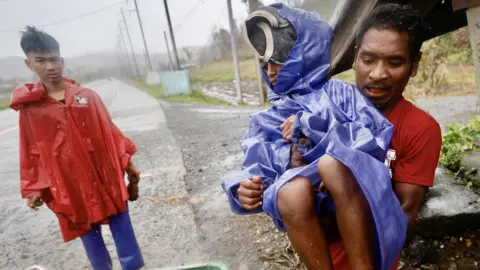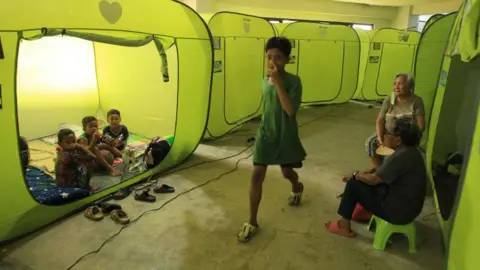A brilliant hurricane has made second landfall on the Philippines’ predominant island of Luzon, with forecasters warning of “life-threatening storm surge”, heavy rains and extreme winds.
Man-Yi, identified regionally as Pepito, first touched down on the nation’s japanese Cantanduanes island at 21:40 native time (13:40 GMT) on Saturday, with most sustained wind speeds of 195 km/h (121mph), the state forecaster stated.
Greater than 1,000,000 individuals have been ordered to evacuate since warnings had been first issued.
Man-Yi is the sixth hurricane to hit the Philippines in a month, with a minimum of 160 individuals identified to have died within the 5 earlier storms.
The tremendous hurricane already ripped by Cantanduanes, the place it uprooted timber, broken some buildings and pulled down energy traces.
The storm didn’t lose any power because it made landfall within the province of Aurora and started traversing the island of Luzon, the Philippines Information Company reported, with some gusts peaking at 305 km/h (189 mph).
Additional widespread heavy rain from Man-Yi is forecast in northern areas of the principle island. Not less than 200mm (7.8 inches) is predicted to fall into Monday, resulting in doubtlessly “life-threatening” flooding and catastrophic mudslides, placing thousands and thousands in danger from storm surges, the federal government stated.
The nation’s capital Manila, the place about 15 million individuals stay, is just not forecast to be within the hurricane’s path.
Earlier on Sunday, dozens of flights had been cancelled because of the incoming storm, in response to native broadcaster ABS-CBN Information.
 EPA
EPA Getty Pictures
Getty PicturesGreater than 500,000 individuals heeded evacuation orders forward of the storm, the civil defence stated. Its head, Ariel Nepomuceno, urged everybody residing within the storm’s projected path to adjust to these orders.
“It’s extra harmful now for these in landslide-prone areas as a result of the bottom has been saturated by the consecutive typhoons,” Mr Nepomuceno stated.
Glenda Llamas was amongst those that needed to depart their properties.
“We’re frightened of the hurricane, as it might intensify and the waters can rise,” she instructed the AFP information company from a shelter within the japanese Luzon province of Albay on Saturday.
“If we did not evacuate we would not have the ability to get out later, we do not have anybody else in the home however us.”
“We have already got numerous phobia because of the earlier calamities that occurred right here like floods, robust winds and different disasters,” stated Melchor Bilay, who was evacuated to a faculty additional south, in Sorsogon province.
 EPA
EPAWhereas typhoons usually are not unusual within the Philippines, forecasters say it’s uncommon to see so many tropical storms within the Pacific on the identical time throughout the month of November.
Tropical Storm Trami dumped one month’s value of rain over giant swathes of the northern Philippines in late October, leaving dozens of individuals lifeless.
This was adopted by Hurricane Kong-rey, wherein a minimum of three individuals had been killed. It was additionally the greatest hurricane to immediately hit Taiwan in almost 30 years.
Hurricane Yinxing affected the north of the island of Luzon earlier this month, the place it introduced almost 250mm (10in) of rain in some areas.
There has since been Hurricane Toraji and, earlier this week, Hurricane Usagi, which introduced a three-metre storm surge and torrential rainfall exceeding 200mm (8 inches).
Storms within the Philippines have change into extra frequent and extra intense, an issue enormously exacerbated by local weather change.
The United Nations’ local weather change physique, the IPCC, has stated that whereas the variety of tropical cyclones that occur globally is unlikely to extend attributable to a warning planet, it’s “very possible” they may have increased charges of rainfall and attain increased prime wind speeds.
This implies the next proportion would attain probably the most intense classes.




